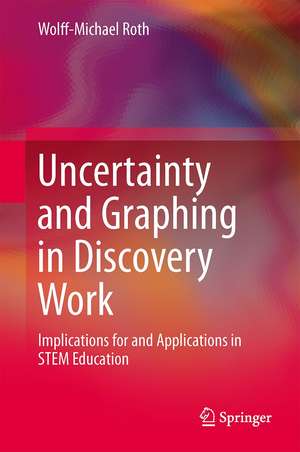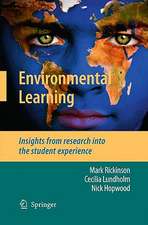Uncertainty and Graphing in Discovery Work: Implications for and Applications in STEM Education
Autor Wolff-Michael Rothen Limba Engleză Hardback – sep 2014
| Toate formatele și edițiile | Preț | Express |
|---|---|---|
| Paperback (1) | 649.06 lei 6-8 săpt. | |
| SPRINGER NETHERLANDS – 10 sep 2016 | 649.06 lei 6-8 săpt. | |
| Hardback (1) | 655.45 lei 6-8 săpt. | |
| SPRINGER NETHERLANDS – sep 2014 | 655.45 lei 6-8 săpt. |
Preț: 655.45 lei
Preț vechi: 771.12 lei
-15% Nou
Puncte Express: 983
Preț estimativ în valută:
125.42€ • 134.12$ • 104.57£
125.42€ • 134.12$ • 104.57£
Carte tipărită la comandă
Livrare economică 18 aprilie-02 mai
Preluare comenzi: 021 569.72.76
Specificații
ISBN-13: 9789400770089
ISBN-10: 9400770081
Pagini: 300
Ilustrații: XVII, 454 p. 149 illus., 106 illus. in color.
Dimensiuni: 155 x 235 x 30 mm
Greutate: 0.84 kg
Ediția:2014
Editura: SPRINGER NETHERLANDS
Colecția Springer
Locul publicării:Dordrecht, Netherlands
ISBN-10: 9400770081
Pagini: 300
Ilustrații: XVII, 454 p. 149 illus., 106 illus. in color.
Dimensiuni: 155 x 235 x 30 mm
Greutate: 0.84 kg
Ediția:2014
Editura: SPRINGER NETHERLANDS
Colecția Springer
Locul publicării:Dordrecht, Netherlands
Public țintă
ResearchCuprins
Preface.- PART A: INTRODUCTION.- 1. Toward a Dynamic Theory of Graphing.- PART B: GRAPHING IN A DISCOVERY SCIENCE.- 2. Radical Uncertainty in/of the Discovery Sciences.- 3. Uncertainties in/of Data Generation.- 4. Coping with Variability.- 5. Undoing Decontextualization.- 6. On Contradictions in Data Interpretation.- 7. A Scientific Revolution that Was Not.- 8. Some Lessons from Discovery Science.- PART C: RETHEORIZING GRAPHING.- 9. Graphing*-in-the-Making.- 10. Graphing in, for, and as Societal Relation.- PART D: UNCERTAINTY AND GRAPHING IN STEM EDUCATION.- 11. Uncertainty, Inquiry, Bricolage.-12. Data and Graphing in STEM Education.- PART D: EPILOGUE.- 13. Discovery Science and Authentic Learning.- Appendix.- References.- Index.
Textul de pe ultima copertă
This book deals with uncertainty and graphing in scientific discovery work from a social practice perspective. It is based on a 5-year ethnographic study in an advanced experimental biology laboratory. The book shows how, in discovery work where scientists do not initially know what to make of graphs, there is a great deal of uncertainty and scientists struggle in trying to make sense of what to make of graphs. Contrary to the belief that scientists have no problem “interpreting” graphs, the chapters in this book make clear that uncertainty about their research object is tied to uncertainty of the graphs. It may take scientists several years of struggle in their workplace before they find out just what their graphs are evidence of. Graphs turn out to stand to the entire research in a part/whole relation, where scientists not only need to be highly familiar with the context from which their data are extracted but also with the entire process by means of which the natural world comes to be transformed and represented in the graph. This has considerable implications for science, technology, engineering, and mathematics education at the secondary and tertiary level, as well as in vocational training. This book discusses and elaborates these implications.
Caracteristici
Presents detailed ethnography of scientific discovery work Discusses new theoretical developments concerning graphing in uncertainty Describes direct implications for and applications in STEM education








